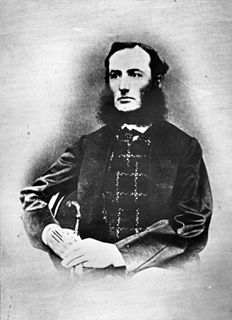Related Research Articles
(John) Ryan Brenan was an Australian politician and an elected member of the New South Wales Legislative Assembly for 68 days in 1856. He founded, and outlined, the suburb of Smithfield in Sydney. Furthermore, Brenan Park, which is in that suburb, was named after him.

The Electoral district of Port Phillip was an electorate of the New South Wales Legislative Council before it became the separate colony of Victoria (Australia) on 1 July 1851. At the time, some members of the Council were elected and the balance were appointed by the Governor. The Town of Melbourne returned one member while the Port Phillip district, which covered the rest of what became Victoria after its separation in 1851, returned five members.

John Sutherland was a builder and politician in colonial New South Wales.
Sir Robert Wisdom, was a politician in colonial New South Wales and Attorney General of New South Wales.
This is a list of members of the New South Wales Legislative Council from 1843 to 1851. The 1843 Electoral Act prescribed 36 members, 24 to be elected, 6 appointed by virtue of their office and 6 nominated. The appointments and elections were for five year terms and thus occurred in 1843,</ref> and 1848. The parliament was dissolved on 30 June 1851 as a result of the 1851 Electoral Act which increased the number of members in the Council to 54.
This is a list of members of the New South Wales Legislative Council from 1851 to 1856. The 1851 Electoral Act increased the number of members in the Council to 54, 18 to be appointed and 36 elected. The initial appointments were made in October 1851.</ref>

Walter Hussey Vivian was an Australian politician.
Augustus Ryan Fraser was a politician and pastoralist in New South Wales, Australia.
James Rodd was an English-born Australian politician.

Abram Orpen Moriarty was an Irish-born Australian politician.

Charles Gilbert Heydon was an Australian politician and judge.
A by-election was held for the New South Wales Legislative Assembly electorate of Goldfields South on 12 December 1870 as a result of the Legislative Assembly declaring the election of Ezekiel Baker was void. Baker had been appointed to conduct a Royal Commission to inquire into the laws and regulations of the goldfields and for securing a permanent water supply. The Committee of Elections and Qualifications held that this appointment was an office of profit under the crown which meant he was incapable of being elected, or of sitting, or voting, as a member of the Assembly.
A by-election was held for the New South Wales Legislative Assembly electorate of Liverpool Plains on 29 January 1870 because Charles Cowper had been appointed Premier and Colonial Secretary, forming the fifth Cowper ministry.
A by-election was held for the New South Wales Legislative Assembly electorate of Liverpool Plains on 9 January 1871 because Charles Cowper had been appointed Agent General in London.
New England, an electoral district of the Legislative Assembly in the Australian state of New South Wales, was created in 1859 and abolished in 1894.
A by-election was held for the New South Wales Legislative Assembly electorate of Tenterfield on 24 August 1874 because Robert Abbott had been appointed Secretary for Mines in the first Parkes ministry. Such ministerial by-elections were usually uncontested.
A by-election was held for the New South Wales Legislative Assembly electorate of Shoalhaven on 21 August 1871 because Thomas Garrett resigned to accept appointment as a police magistrate at Berrima.
A by-election was held for the New South Wales Legislative Assembly electorate of Redfern on 9 March 1886 because Arthur Renwick was appointed Minister of Public Instruction in the ministry of Sir Patrick Jennings. Under the constitution, ministers in the Legislative Assembly were required to resign to recontest their seats in a by-election when appointed. Such ministerial by-elections were usually uncontested and on this occasion a poll was required for Redfern and Bathurst where Francis Suttor was easily re-elected. The 7 other ministers were re-elected unopposed.
A by-election was held for the New South Wales Legislative Assembly electorate of South Sydney on 4 June 1887 because Bernhard Wise was appointed Attorney General in the fourth Parkes ministry. Such ministerial by-elections were usually uncontested. Most of the ministry was not required to face a by-election as they had been appointed prior to the general election in February 1887. William Foster had been the Attorney General however he resigned on the ground that he had been promised an appointment to the Supreme Court and Henry Stephen had been appointed instead.
A by-election was held for the New South Wales Legislative Assembly electorate of Tenterfield on 6 February 1882 because of the resignation of John Dillon, to accept an appointment as senior stipendiary magistrate.
References
- 1 2 "Mr Charles Thomas Weaver (1817-1874)". Former Members of the Parliament of New South Wales . Retrieved 21 May 2019.
- 1 2 "Appointment of magistrates". New South Wales Government Gazette (190). 1 August 1871. p. 1670. Retrieved 11 February 2021– via Trove.
- ↑ "Writ of election: New England". New South Wales Government Gazette (188). New South Wales, Australia. 29 July 1871. p. 1661. Retrieved 9 June 2021– via Trove.
- ↑ Green, Antony. "1871 New England by-election". New South Wales Election Results 1856-2007. Parliament of New South Wales . Retrieved 9 June 2021.